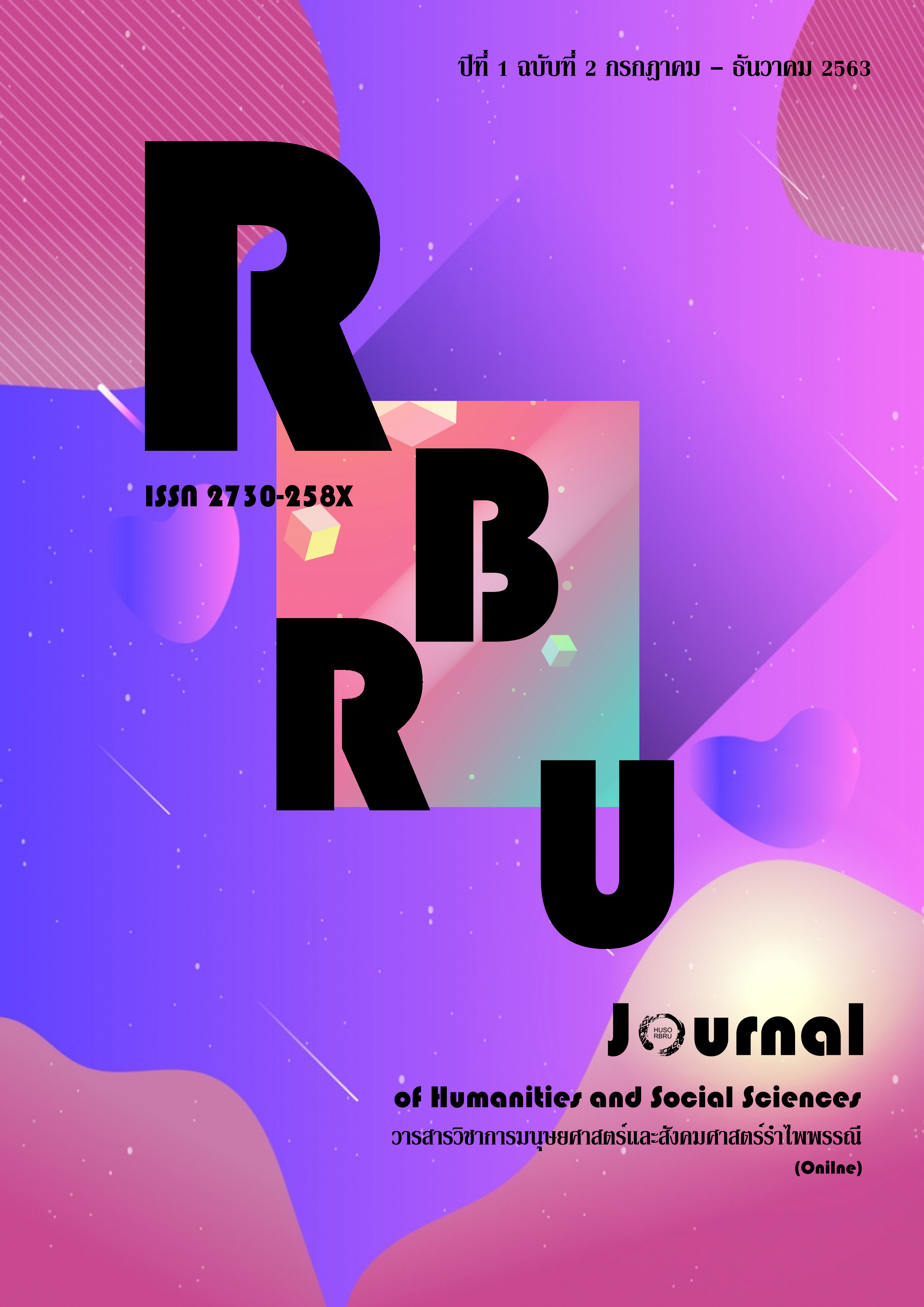Vietnamese Tones Syetem of The Viet Kieu in Mukdahan, Thailand. เสียงวรรณยุกต์ในภาษาเวียดนามของคนไทยเชื้อสายเวียดนาม (เวียดเกี่ยว) ในจ.มุกดาหาร
Main Article Content
Abstract
Mukdahan Province, Thailand is one of the places with the largest Viet Kieu community in Thailand. Vietnamese language herein is widely used and has become the third foreign language for students in Thailand to choose to study. This is a research project to describe the characteristics of the Vietnamese tone system of the Viet Kieu in Mukdahan, Thailand. The source of information was collected by the method of direct recording from 16 participants with the word list having all the tones in Vietnamese language in 4 types of syllables including open syllables, half-open syllables, half-closed syllables and closed syllables. The research results show that in Vietnamese language of the Viet Kieu in Mukdahan, there are 5 tones and 2 variants of “Non-flat, high raising tone” (thanh sắc) and “Non-flat, low falling tone” (thanh nặng). “Flat, high tone” (thanh ngang) [34] is a flat tone but has a high ending like “Non-flat, high raising tone” (thanh sắc). “Flat, low tone” (thanh huyền) [32] is a smoothly flat tone and ends at a low pitch. “Non-flat, high falling-raising tone” (thanh ngã) [325] is a low, non-flat and high falling-raising tone and ends at a high pitch. “Non-flat, low falling-raising tone” (thanh hỏi) and “Non-flat, low falling tone” (thanh nặng) [31] are the strongly-low tones and then end. “Non-flat, high raising tone” (thanh sắc) [25] is a high tone.
Article Details
เนื้อหาและข้อมูลในบทความที่ลงตีพิมพ์ในวารสารถือเป็นข้อคิดเห็นและความรับผิดชอบของผู้เขียนบทความโดยตรงซึ่งกองบรรณาธิการวารสาร ไม่จำเป็นต้องเห็นด้วย หรือร่วมรับผิดชอบใดๆ
บทความ ข้อมูล เนื้อหา รูปภาพ ฯลฯ ที่ได้รับการตีพิมพ์ในวารสารวิชาการมนุษยศาสตร์และสังคมศาสตร์รำไพพรรณี ถือเป็นลิขสิทธิ์ของวารสาร หากบุคคลหรือหน่วยงานใดต้องการนำทั้งหมดหรือส่วนหนึ่งส่วนใดไปเผยแพร่ต่อหรือเพื่อกระทำการใดๆ จะต้องได้รับอนุญาตเป็นลายลักอักษรจากวารสารวิชาการมนุษยศาสตร์และสังคมศาสตร์รำไพพรรณีก่อนเท่านั้น
References
Andrea Hoa Pham. (2003). Vietnamese Tone: A New Analysis. Routledge: New York.
Andrea Hoa Pham. (2005). Vietnamese tonal system in Nghi Loc dialect - A preliminary report. T. Toronto Working Papers in Linguistics- Special Issue on Similarity in Phonology. (24): 183-201.
Andrea Hoa Pham. (2009). The identity of non-identified sounds: glottal stop, prevocalic /w/ and triphthongs in Vietnamese. Proceedings of the 3rd Toronto Workshop on East Asian Languages. Toronto: University of Toronto Press.
Cao Xuan Hao. (2003). Vietnamese language: some issues on phonetics, grammar, semantics. 2nd edition. Da Nang: Education Publishing House.
Doan Thien Thuan. (1999). Ngu am tieng Viet, (In Vietnamese) (Vietnamese Phonetics). Hanoi: Publishing House of Vietnam National University.
Hoang Thi Chau. (2008). Phuong ngu hoc tieng Viet, (In Vietnamese) [Vietnamese Dialectology]. Hanoi: Publishing House of Vietnam National University.
James P.Kirby. (2011). Vietnamese (Hanoi Vietnamese). Journal of the International Phonetic Association. 41(3): 38-392.
Mai Ngoc Chu. (2013). Co so ngon ngu hoc va tieng Viet, (In Vietnamese) [Introduction to Linguistics and Vietnamese Language]. Hanoi: Vietnam Education Publishing House.
Nguyen Thi Hai. (2017). Ngu am tieng Viet hien dai, (In Vietnamese) [Modern Vietnamese Phonetics]. Ho Chi Minh City: Youth Publishing House.
Nguyen Van Loi. (2009). Formation of writing of tones in Vietnamese language. (online). Form https://bit.ly/3jok8cV. (May 20, 2020).
Nguyễn Văn Khang. (1999). Ngon ngu hoc xa hoi, nhung van de co ban, (In Vietnamese) [Social linguistics fundamentals]. Hanoi: Vietnam Education Publishing House.
Phatcharaphong Phubetpeerawat. (2014). Khao sat he thong ngu am tieng Viet cua nguoi Thai Lan goc Viet ow huyen Muang, tinh Nakhon Phanom (co lien he voi tieng Viet o Viet Nam), (In Vietnamese) [Surveying Vietnamese phonetic system of Thai people of Vietnamese descent in Muang district, Nakhon Phanom province (related to Vietnamese language in Vietnam)]. Master’s Thesis, University of Social Sciences and Humanities, Vietnam National University, Hanoi.
Phatcharaphong Phubetpeerawat. (2014). Surveying the Vietnamese phonetic system of Thai people of Vietnamese descent in Muang district, Nakhon Phanom province (related to Vietnamese language in Vietnam). Master’s thesis, University of Social Sciences and Humanities, Vietnam National University, Hanoi.
Ta Thanh Tan. (2004). He thong ngu am tho ngu Phuc Le-Thuy Nguyen-Hai Phong (Dua tren cu lieu phan tich bang computer), (In Vietnamese). Journal of Language and Life, Tạp chí Ngôn ngữ và Đời sống. 2016(7): 1-11.
Thompson, L. C. (1985). A Vietnamese grammar. Mon-Khmer Studies. 13(14): 1-367.
Tran Tri Doi (2011). Mot so van de nghien cuu so sanh-lich su nhom ngon ngu Viet Muong, (In Vietnamese) [Some comparative historical research issues on Viet Muong language groups]. Hanoi: Publishing House of Vietnam National University.
Trinh Cam Lan. (2007). Su bien doi ngon tu cua cac cong dong chuyencu den Thu do (nghien cuu truong hop cong dong Nghe Tinh o Ha Noi), (In Vietnamese) [Language variation of the communities moving to the capital (case study of Nghe Tinh community in Hanoi)]. Hanoi: Social Science Publishing House.
Vo Xuan Trang. (1997). Phuong ngu Binh Tri Thien, (In Vietnamese) [Binh Tri Thien Dialect]. Hanoi: Social Science Publishing House.
Vu Duc Nghieu (Editor), Nguyen Van Hiep. (2009). Dan luan ngon ngu hoc, (In Vietnamese) [Introduction to Linguistics]. Hanoi: Publishing House of Vietnam National University.


